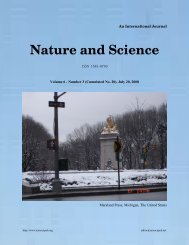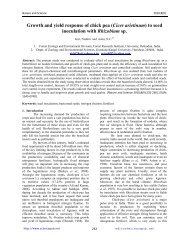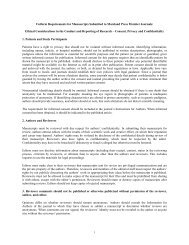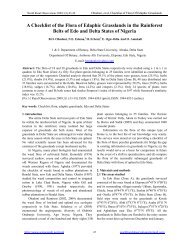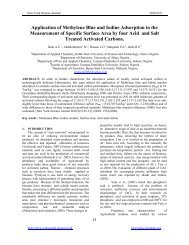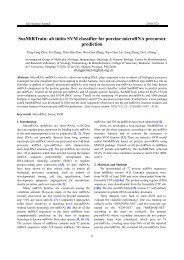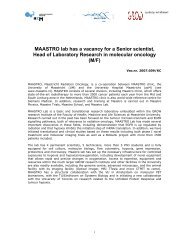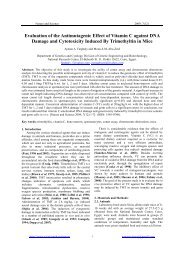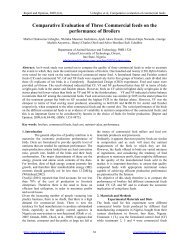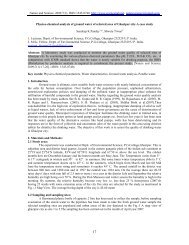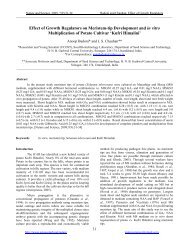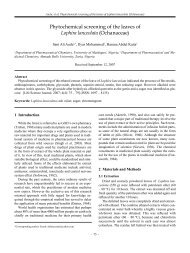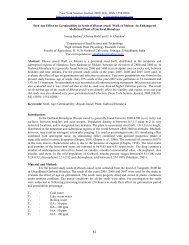Ecological, Social and Commercial Role of Lichens in India with ...
Ecological, Social and Commercial Role of Lichens in India with ...
Ecological, Social and Commercial Role of Lichens in India with ...
Create successful ePaper yourself
Turn your PDF publications into a flip-book with our unique Google optimized e-Paper software.
Acdemia Arena 2010, Supplement 0201<br />
http://www.sciencepub.net<br />
International treaty, Agenda 21 emphasize regular monitor<strong>in</strong>g through sampl<strong>in</strong>g <strong>and</strong> other<br />
techniques, the components <strong>of</strong> biodiversity especially pay<strong>in</strong>g particular attention to those requir<strong>in</strong>g<br />
urgent conservation measures. Thus, biological diversity is now <strong>in</strong>creas<strong>in</strong>gly recognized as a vital<br />
parameter to asses global <strong>and</strong> local environmental changes <strong>and</strong> susta<strong>in</strong>ability <strong>of</strong> developmental<br />
activities. The development <strong>of</strong> <strong>in</strong>formation on the lichen ecology is widely scattered <strong>of</strong>ten <strong>in</strong> many<br />
<strong>in</strong>accessible literature sources. Seaward (1977) complied the knowledge on lichens <strong>in</strong> relation to<br />
physical <strong>and</strong> biological component <strong>of</strong> their environment.<br />
Upreti <strong>and</strong> Chaterjee (1999a) studied the distribution <strong>of</strong> epiphytic lichens on Quercus <strong>and</strong><br />
P<strong>in</strong>us trees <strong>in</strong> Pithoragarh <strong>and</strong> Almora districts <strong>of</strong> Kumaun Himalayas. Quercus semecarpifolia<br />
exhibits the dom<strong>in</strong>ance <strong>of</strong> lichen species represented by 25 species while Quercus leucotrichophora<br />
<strong>and</strong> Quercus floribunda have 20 <strong>and</strong> 12 species respectively. All tree species have dom<strong>in</strong>ance <strong>of</strong><br />
Parmelioid species. The cultivated tree <strong>of</strong> P<strong>in</strong>us roxburghii show occurrence <strong>of</strong> 19 species <strong>of</strong><br />
lichens. Upreti <strong>and</strong> Chaterjee (1999b) also studied the epiphytic lichen flora <strong>of</strong> Quercus <strong>and</strong> P<strong>in</strong>us<br />
trees <strong>in</strong> three forest sites <strong>of</strong> Pithoragarh district, Quercus leucotrichophora at altitude between<br />
2700-3000m has 24 species while Quercus dilatata at the same elevation has only 15 species <strong>of</strong><br />
lichen. Both the tree species have dom<strong>in</strong>ance <strong>of</strong> Usenea <strong>and</strong> Ramal<strong>in</strong>a species. Quercus<br />
leucotrichophora at lower elevation between 1600-1800m has 14 species <strong>of</strong> lichens. P<strong>in</strong>us<br />
roxburghii between altitudes <strong>of</strong> 15001600m has 21 epiphytic species <strong>in</strong> the area. Both Quercus <strong>and</strong><br />
P<strong>in</strong>us trees at lower elevation exhibit dom<strong>in</strong>ance <strong>of</strong> Parmelioid lichens.<br />
Nayaka <strong>and</strong> Upreti (2002) studied the lichen communities <strong>of</strong> Sharavati River Bas<strong>in</strong>,<br />
Karnataka, while Srivastava (2006) studied the Great Himalaya National Park, Himanchal Pradesh.<br />
Divakar <strong>and</strong> Upreti (2005) <strong>and</strong> Kumar (2008) proposed the Chopta-Tunganath, Saryu River<br />
Valley <strong>in</strong> P<strong>in</strong>dari Glacier (Bageshwar district), Na<strong>in</strong> S<strong>in</strong>gh top en route Milam Glacier, Chaubatia<br />
to Ranikhet (Almora district) <strong>and</strong> Mussoorie Hills (Dehra Dun district) <strong>of</strong> Uttarakh<strong>and</strong> areas as the<br />
“Lichen Sanctuary” ow<strong>in</strong>g <strong>of</strong> their rich, unique <strong>and</strong> some endemic lichen taxa.<br />
Negi (2000) studied total 3211 colonies <strong>of</strong> microlichens from twelve 50m X 1m plots<br />
distributed across four microhabitat (vegetation) types between 1500-3700m <strong>in</strong> Chopta-Tunganath<br />
l<strong>and</strong>scape <strong>of</strong> Garhwal Himalaya. This study revealed occurrence <strong>of</strong> 85 species, 15 genera fall<strong>in</strong>g<br />
under 13 families. Lobaria retigera stood as a broad niche generalist species <strong>with</strong> moderate levels<br />
<strong>of</strong> abundance <strong>in</strong> all the three major microhabitats, viz. rock, soil <strong>and</strong> wood across 83% <strong>of</strong> all the<br />
plots sampled, whereas Umblicaria <strong>in</strong>dica occurr<strong>in</strong>g on rock substrates. Heterodermia <strong>in</strong>cana <strong>and</strong><br />
22



